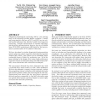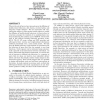BIOSTEC
2011
12 years 11 months ago
2011
In this article we describe a new wireless biosignal system which monitors in a long-term basis, the users at their homes. The system consists of wearable sensors that measure hear...
WH
2010
13 years 6 months ago
2010
Ubiquitous physiological monitoring will be a key driving force in the upcoming wireless health revolution. Cardiac and brain signals in the form of ECG and EEG are two critical h...
WH
2010
13 years 6 months ago
2010
Patients with end stage renal diseases (ESRD) on hemodialysis (HD) have high morbidity and mortality due to multiple causes, one of which is dramatically higher fall rates than th...
WH
2010
13 years 6 months ago
2010
Body Sensor Networks (BSNs) consist of sensor nodes deployed on the human body for health monitoring. Each sensor node is implemented by interfacing a physiological sensor with a ...
WH
2010
13 years 6 months ago
2010
WH
2010
13 years 6 months ago
2010
In this work, we consider low power, wearable pulse oximeter sensors for ambulatory, remote vital signs monitoring applications. It is extremely important for such sensors to main...
WH
2010
13 years 6 months ago
2010
The advancement of precision micropower amplifiers, microcontrollers, and MEMs devices have allowed for a paradigm shift from traditionally large and costly health monitoring equi...
WH
2010
13 years 6 months ago
2010
What is the role of face-to-face interactions in the diffusion of health-related behaviors- diet choices, exercise habits, and long-term weight changes? We use co-location and com...
WH
2010
13 years 6 months ago
2010
Systems with wearable and wireless motion sensors have been receiving significant attention in the past few years specifically for the applications of human movement monitoring. O...
WH
2010
13 years 6 months ago
2010
Advances in mobile phone technology have allowed phones to become a convenient platform for real-time assessment of a participants health and behavior. AndWellness, a personal dat...


